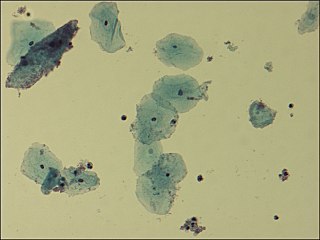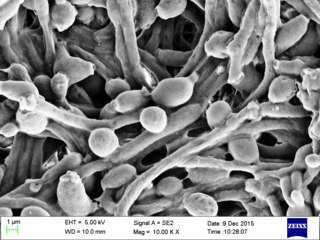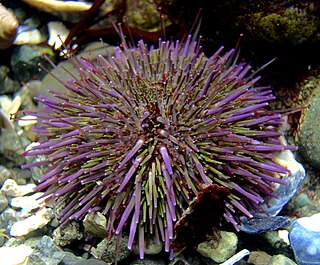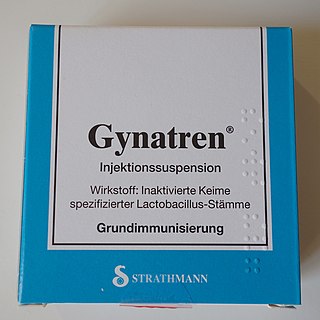Related Research Articles

Trichomoniasis (trich) is an infectious disease caused by the parasite Trichomonas vaginalis. About 70% of affected people do not have symptoms when infected. When symptoms occur, they typically begin 5 to 28 days after exposure. Symptoms can include itching in the genital area, a bad smelling thin vaginal discharge, burning with urination, and pain with sex. Having trichomoniasis increases the risk of getting HIV/AIDS. It may also cause complications during pregnancy.

Excavata is an extensive and diverse but paraphyletic group of unicellular Eukaryota. The group was first suggested by Simpson and Patterson in 1999 and the name latinized and assigned a rank by Thomas Cavalier-Smith in 2002. It contains a variety of free-living and symbiotic protists, and includes some important parasites of humans such as Giardia and Trichomonas. Excavates were formerly considered to be included in the now obsolete Protista kingdom. They were distinguished from other lineages based on electron-microscopic information about how the cells are arranged. They are considered to be a basal flagellate lineage.

Giardia duodenalis, also known as Giardia intestinalis and Giardia lamblia, is a flagellated parasitic protozoan microorganism of the genus Giardia that colonizes the small intestine, causing a diarrheal condition known as giardiasis. The parasite attaches to the intestinal epithelium by an adhesive disc or sucker, and reproduces via binary fission. Giardiasis does not spread to other parts of the gastrointestinal tract, but remains confined to the lumen of the small intestine. The microorganism has an outer membrane that makes it possible to survive even when outside of its host, and which can render it tolerant to certain disinfectants. Giardia trophozoites are anaerobic, and absorb their nutrients from the intestinal lumen. If the organism is stained, its characteristic pattern resembles the familiar "smiley face" symbol.

Gardnerella vaginalis is a species of Gram-variable-staining facultative anaerobic bacteria. The organisms are small non-spore-forming, nonmotile coccobacilli.

Candida albicans is an opportunistic pathogenic yeast that is a common member of the human gut flora. It can also survive outside the human body. It is detected in the gastrointestinal tract and mouth in 40–60% of healthy adults. It is usually a commensal organism, but it can become pathogenic in immunocompromised individuals under a variety of conditions. It is one of the few species of the genus Candida that cause the human infection candidiasis, which results from an overgrowth of the fungus. Candidiasis is, for example, often observed in HIV-infected patients. C. albicans is the most common fungal species isolated from biofilms either formed on (permanent) implanted medical devices or on human tissue. C. albicans, C. tropicalis, C. parapsilosis, and C. glabrata are together responsible for 50–90% of all cases of candidiasis in humans. A mortality rate of 40% has been reported for patients with systemic candidiasis due to C. albicans. By one estimate, invasive candidiasis contracted in a hospital causes 2,800 to 11,200 deaths yearly in the US. Nevertheless, these numbers may not truly reflect the true extent of damage this organism causes, given new studies indicating that C. albicans can cross the blood–brain barrier in mice.

Trichomonas vaginalis is an anaerobic, flagellated protozoan parasite and the causative agent of a sexually transmitted disease called trichomoniasis. It is the most common pathogenic protozoan that infects humans in industrialized countries. Infection rates in men and women are similar but women are usually symptomatic, while infections in men are usually asymptomatic. Transmission usually occurs via direct, skin-to-skin contact with an infected individual, most often through vaginal intercourse. The WHO has estimated that 160 million cases of infection are acquired annually worldwide. The estimates for North America alone are between 5 and 8 million new infections each year, with an estimated rate of asymptomatic cases as high as 50%. Usually treatment consists of metronidazole and tinidazole.
The parabasalids are a group of flagellated protists within the supergroup Excavata. Most of these eukaryotic organisms form a symbiotic relationship in animals. These include a variety of forms found in the intestines of termites and cockroaches, many of which have symbiotic bacteria that help them digest cellulose in woody plants. Other species within this supergroup are known parasites, and include human pathogens.
Trichomonas is a genus of anaerobic excavate parasites of vertebrates. It was first discovered by Alfred François Donné in 1836 when he found these parasites in the pus of a patient suffering from vaginitis, an inflammation of the vagina. Donné named the genus from its morphological characteristics. The prefix tricho- originates from the Ancient Greek word θρίξ (thrix) meaning hair, describing Trichomonas’s flagella. The suffix -monas, describes its similarity to unicellular organisms from the genus Monas.

A hydrogenosome is a membrane-enclosed organelle found in some anaerobic ciliates, flagellates, and fungi. Hydrogenosomes are highly variable organelles that have presumably evolved from protomitochondria to produce molecular hydrogen and ATP in anaerobic conditions.

Borrelia burgdorferi is a bacterial species of the spirochete class in the genus Borrelia, and is one of the causative agents of Lyme disease in humans. Along with a few similar genospecies, some of which also cause Lyme disease, it makes up the species complex of Borrelia burgdorferi sensu lato. The complex currently comprises 20 accepted and 3 proposed genospecies. B. burgdorferi sensu stricto exists in North America and Eurasia and until 2016 was the only known cause of Lyme disease in North America. Borrelia species are Gram-negative.

Claire M. Fraser is an American genome scientist and microbiologist who has worked in microbial genomics and genome medicine. Her research has contributed to the understanding of the diversity and evolution of microbial life. Fraser is the director of the Institute for Genome Sciences at the University of Maryland School of Medicine in Baltimore, MD, where she holds the Dean's Endowed Professorship in the School of Medicine. She has joint faculty appointments at the University of Maryland School of Medicine in the Departments of Medicine and Microbiology/Immunology. In 2019, she began serving a one-year term as President-Elect for the American Association for the Advancement of Science (AAAS), which will be followed by a one-year term as AAAS president starting in February 2020 and a one-year term as chair of the Board of Directors in February 2021.

Tritrichomonas foetus is a species of single-celled flagellated parasites that is known to be a pathogen of the bovine reproductive tract as well as the intestinal tract of cats. In cattle, the organism is transmitted to the female vagina and uterus from the foreskin of the bull where the parasite is known to reside. It causes infertility, and, at times, has caused spontaneous abortions in the first trimester. In the last ten years, there have been reports of Tritrichomonas foetus in the feces of young cats that have diarrhea and live in households with multiple cats. Tritrichomonas foetus looks similarly to Giardia and is often misdiagnosed for it when viewed under a microscope.

Pseudomonas syringae is a rod-shaped, Gram-negative bacterium with polar flagella. As a plant pathogen, it can infect a wide range of species, and exists as over 50 different pathovars, all of which are available to researchers from international culture collections such as the NCPPB, ICMP, and others.

Strongylocentrotus purpuratus is a species of sea urchin in the family Strongylocentrotidae commonly known as the purple sea urchin. It lives along the eastern edge of the Pacific Ocean extending from Ensenada, Mexico, to British Columbia, Canada. This sea urchin species is deep purple in color, and lives in lower inter-tidal and nearshore sub-tidal communities. Its eggs are orange when secreted in water. January, February, and March function as the typical active reproductive months for the species. Sexual maturity is reached around two years. It normally grows to a diameter of about 10 cm (4 inches) and may live as long as 70 years.

Protozoan infections are parasitic diseases caused by organisms formerly classified in the kingdom Protozoa. These organisms are now classified in the supergroups Excavata, Amoebozoa, Harosa, and Archaeplastida. They are usually contracted by either an insect vector or by contact with an infected substance or surface.
In biology, a pathogen, in the oldest and broadest sense, is any organism or agent that can produce disease. A pathogen may also be referred to as an infectious agent, or simply a germ.
Jane M. Carlton is a biologist at New York University whose research centers on the genomics of two groups of single-celled parasites: those which cause malaria, and trichomonads, which include the common sexually transmitted parasite Trichomonas vaginalis.

Trichomonas tenax, or oral trichomonas, is a species of Trichomonas commonly found in the oral cavity of humans. Routine hygiene is generally not sufficient to eliminate the parasite, hence its Latin name, meaning "tenacious". The parasite is frequently encountered in periodontal infections, affecting more than 50% of the population in some areas, but it is usually considered insignificant. T. tenax is generally not found on the gums of healthy patients. It is known to play a pathogenic role in necrotizing ulcerative gingivitis and necrotizing ulcerative periodontitis, worsening preexisting periodontal disease. This parasite is also implicated in some chronic lung diseases; in such cases, removal of the parasite is sufficient to allow recovery.
Tc1/mariner is a class and superfamily of interspersed repeats DNA transposons. The elements of this class are found in all animals, including humans. They can also be found in protists and bacteria.

Lactobacillus vaccines are used in the therapy and prophylaxis of non-specific bacterial vaginitis and trichomoniasis. The vaccines consist of specific inactivated strains of Lactobacilli, called "aberrant" strains in the relevant literature dating from the 1980s. These strains were isolated from the vaginal secretions of patients with acute colpitis. The lactobacilli in question are polymorphic, often shortened or coccoid in shape and do not produce an acidic, anti-pathogenic vaginal environment. A colonization with aberrant lactobacilli has been associated with an increased susceptibility to vaginal infections and a high rate of relapse following antimicrobial treatment. Intramuscular administration of inactivated aberrant lactobacilli provokes a humoral immune response. The production of specific antibodies both in serum and in the vaginal secretion has been demonstrated. As a result of the immune stimulation, the abnormal lactobacilli are inhibited, the population of normal, rod-shaped lactobacilli can grow and exert its defense functions against pathogenic microorganisms.
References
- 1 2 3 4 "2019 NAS Election". www.nasonline.org.
- ↑ Dyall, Sabrina D.; Brown, Mark T.; Johnson, Patricia J. (2004). "Ancient Invasions: From Endosymbionts to Organelles". Science. 304 (5668): 253–257. Bibcode:2004Sci...304..253D. doi:10.1126/science.1094884. ISSN 0036-8075. PMID 15073369. S2CID 19424594.

- 1 2 3 4 5 "Cellular crosstalk and disease pathogenesis". researchfeatures.com. 2018-05-31. Retrieved 2019-05-05.
- ↑ "Murray State University 2019 Distinguished Alumni Spotlights – The Blue & Gold". msublueandgold.org. Retrieved 2019-05-05.
- 1 2 Johnson, Patricia Jean (1984). A molecular comparison of actin genes in sea urchins (Strongylocentrotus franciscanus, S. purpuratus, and Lytechinus pictus) (PhD thesis). University of Michigan. OCLC 68294642.
- 1 2 "2014 SCEP Symposium". Southern California Eukaryotic Pathogen Symposium. Retrieved 2019-05-06.
- ↑ Johnson, Patricia J.; Carlton, Jane M.; Yan, Weihong; Vaňáčová, Štěpánka (2005). "Spliceosomal introns in the deep-branching eukaryote Trichomonas vaginalis". Proceedings of the National Academy of Sciences. 102 (12): 4430–4435. Bibcode:2005PNAS..102.4430V. doi: 10.1073/pnas.0407500102 . ISSN 0027-8424. PMC 554003 . PMID 15764705.
- ↑ "Patricia Jean Johnson - Professor of Biochemistry and Molecular Genetics, Immunology and Microbiology in Los Angeles, California, United States of America | eMedEvents". emedevents.com. Retrieved 2019-05-05.
- ↑ "The World's Smallest Genome Just Got Smaller". npr.org. Retrieved 2019-05-06.
- 1 2 3 4 "UCLA and NYU microbiologists crack genome of a parasite that causes a common STD". eurekalert.org. Retrieved 2019-05-06.
- 1 2 Carlton, J. M.; Hirt, R. P.; Silva, J. C.; Delcher, A. L.; Schatz, M.; Zhao, Q.; Wortman, J. R.; Bidwell, S. L.; Alsmark, U. C. M.; Besteiro, S.; Sicheritz-Ponten, T.; Noel, C. J.; Dacks, J. B.; Foster, P. G.; Simillion, C.; Van de Peer, Y.; Miranda-Saavedra, D.; Barton, G. J.; Westrop, G. D.; Muller, S.; Dessi, D.; Fiori, P. L.; Ren, Q.; Paulsen, I.; Zhang, H.; Bastida-Corcuera, F. D.; Simoes-Barbosa, A.; Brown, M. T.; Hayes, R. D.; Mukherjee, M.; Okumura, C. Y.; Schneider, R.; Smith, A. J.; Vanacova, S.; Villalvazo, M.; Haas, B. J.; Pertea, M.; Feldblyum, T. V.; Utterback, T. R.; Shu, C.-L.; Osoegawa, K.; de Jong, P. J.; Hrdy, I.; Horvathova, L.; Zubacova, Z.; Dolezal, P.; Malik, S.-B.; Logsdon, J. M.; Henze, K.; Gupta, A.; Wang, C. C.; Dunne, R. L.; Upcroft, J. A.; Upcroft, P.; White, O.; Salzberg, S. L.; Tang, P.; Chiu, C.-H.; Lee, Y.-S.; Embley, T. M.; Coombs, G. H.; Mottram, J. C.; Tachezy, J.; Fraser-Liggett, C. M.; Johnson, P. J. (2007). "Draft Genome Sequence of the Sexually Transmitted Pathogen Trichomonas vaginalis". Science. 315 (5809): 207–212. Bibcode:2007Sci...315..207C. doi:10.1126/science.1132894. ISSN 0036-8075. PMC 2080659 . PMID 17218520.
- 1 2 "Patricia J. Johnson, Ph.D. – Department of Microbiology, Immunology and Molecular Genetics". ucla.edu. Retrieved 2019-05-05.
- ↑ Bui, E. T.; Bradley, P. J.; Johnson, P. J. (1996). "A common evolutionary origin for mitochondria and hydrogenosomes". Proceedings of the National Academy of Sciences. 93 (18): 9651–9656. Bibcode:1996PNAS...93.9651B. doi: 10.1073/pnas.93.18.9651 . ISSN 0027-8424. PMC 38483 . PMID 8790385.
- ↑ Twu, O.; Dessi, D.; Vu, A.; Mercer, F.; Stevens, G. C.; de Miguel, N.; Rappelli, P.; Cocco, A. R.; Clubb, R. T.; Fiori, P. L.; Johnson, P. J. (2014). "Trichomonas vaginalis homolog of macrophage migration inhibitory factor induces prostate cell growth, invasiveness, and inflammatory responses". Proceedings of the National Academy of Sciences. 111 (22): 8179–8184. Bibcode:2014PNAS..111.8179T. doi: 10.1073/pnas.1321884111 . ISSN 0027-8424. PMC 4050605 . PMID 24843155.
- 1 2 Roberts, Michelle (2014-05-20). "Prostate cancer 'linked to sex bug'". bbc.com. BBC . Retrieved 2019-05-05.
- ↑ "PLOS Pathogens: A Peer-Reviewed Open-Access Journal". journals.plos.org. Retrieved 2019-05-05.
- ↑ Johnson, Patricia. "Biogenesis of Hydrogenosomes of a Trichomonad Parasite". grantome.org.